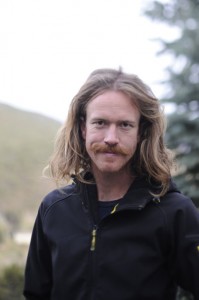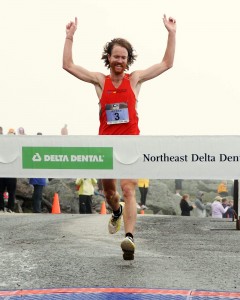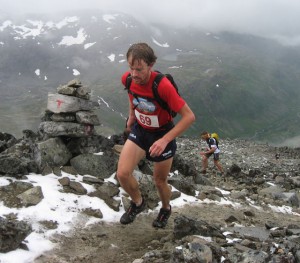This article was first published on April 11, 2012, on Trail Runner magazine’s website. In case you missed my interview with Rickey there, I’m reposting it here.
UPDATE February 2014: Salomon Running TV just produced this great video of Rickey. Definitely watch it to appreciate the gorgeous landscapes of the Southwest and Northern California, and to hear his perspectives on travel and trail running.
In a sport not lacking offbeat characters with exceptional endurance, Rickey Gates stands out.
Trail running’s Kerouac-quoting, motorcycle-riding nomad with the serious ’stache and tangled tresses established himself as a champion mountain runner at shorter distances while racing around the globe. Then he entered his first ultra last summer—the 80-mile Canadian Death Race—and won it in 12:15, knocking 32 minutes off the course record held by Hal Koerner.
In 2007, at age 26, Gates was named USA Track and Field Mountain Runner of the Year, having won both the U.S. Mountain Running Championship and U.S. Trail Championship in back-to-back weeks. Outside Online named him one of “The Fittest Real Men in America.” He twice won the grueling uphill, 7.6-mile Mount Washington Road Race in the White Mountains of New Hampshire and set a record for the fastest known time (FKT) running Yosemite’s Half Dome (2:28:18, 16 miles roundtrip and nearly 5000 vertical feet).
In 2011, he won the South Pole Marathon (only the second time the event has been held, following an infamous inaugural run with Dean Karnazes and others in 2002). Last year alone, he moved around from the South Pole to Moab, from New Zealand to France to Mexico, back to his home base near Aspen, Colorado, and finally settled (for the time being) in San Francisco.
In the short time he and I swapped emails for this interview, he headed to Yosemite for snowy springtime running and took off for a week in Greece, where he and other trail runners of Team Salomon are training and testing products. He also launched a website (rickeygates.com) to showcase his photography and writing.
His schedule for 2012 includes the Transvulcania (83K) in the Canary Islands, the Zegama Marathon in Spain, the Three Peaks 23-miler in the UK and Mount Washington in June. He’s also eyeing the FKT record for running up and down the Grand Teton. And, he adds, there’s a good chance he’ll seek redemption at the NFEC50 in December.
Last December, I met Rickey at the finish line of the North Face Endurance Challenge 50-miler (NFEC50) in San Francisco and observed how he handled his disappointing performance—what he later described as “a death march”—with serenity. Since I’m a fan of his writing for Trail Runner (“Just Kilian,” December 2011, Issue 76, “Nobody Looks for You in Mexico,” March 2012, Issue 78) and curious about his globetrotting, I reached out to ask him some questions.
Q&A
Sarah: Tell us about your recent crossover to ultras.
Rickey: First, I really didn’t cross over to ultras. I am not an ultrarunner. I’m not a fan of the title. I suppose that some people like to wear that as a badge of sorts, but it doesn’t really do anything for me, as I believe that anybody can do one.
OK. Last year, you set a course record at your first ultra, but your third ultra (the NFEC in San Francisco last December) turned into a 34th place disappointment. How are you feeling about ultrarunning now?
I’ve enjoyed what little experience I have in ultras. I feel like I have the shorter races more or less sorted out—I know how to train for them; I know how to race them. Ultras—I have a bit more to learn. It’s not as easy as just running a bunch of miles. Rest is so important. That was the biggest lesson for me at the NFEC50: learn when to rest and how much.
You wrote in your blog that you thought you could win the NFEC50, but then your legs told you otherwise and you faded in the second half. Later, you blamed the performance on “wanting it too much.” What did you learn from the experience?
My mistake with the NFEC50 was ignoring all the training that I had already done earlier in the year. … Other racers might disagree with me, but by the time December rolls around, you’ve either put in the work or you haven’t. I erred on the side of too much training, and, by the time the race rolled around, I was completely spent.
How do you know when and how much to rest, and what about the training benefits of running on tired legs?
Tired legs are good at the beginning of the season. Tired legs at the end of the season mean something different. … I am not a coach. I’d be an awful coach. My one-and-only suggestion is that people listen to their bodies. I obviously don’t have it figured out completely. That’s part of the fun: experimenting, sometimes failing, sometimes succeeding.
Last year, you paced two phenomenal 100-mile champions, Kilian Jornet at Western States and Julien Chorier at Hardrock. What did you learn from being on the course with them, and did it make you want to be in their shoes—that is, did it make you want to run and win those marquee 100s?
I didn’t learn all that much from Kilian or Julien, other than that they are incredibly strong human beings. Running an ultra is such an experiential thing, not something that translates all that well over to somebody that hasn’t run one before. I wouldn’t say that I wanted to be in their shoes at any one point, but would love to have had the experience. I don’t know quite what the difference is there.
Last summer, after winning the Mount Washington a second time, you were battling a calf injury. Has it flared up, and are you presently managing any other injuries?
The calf injury hasn’t been back. I’ve been dealing with a hamstring issue for quite some time. It’s very frustrating but is teaching me some new things: relax, be patient, etc. Because of my hamstring, my training has been minimal: light miles, some bike.
Do you do any PT or cross training to help your hamstrings specifically or to help prevent injury generally?
When people are getting into running, it is essential to include the entire package: stretching, massage and strengthening. This video by Boulder coach Jay Johnson is a great five-minute daily strengthening routine. Perform these three things and you’re guaranteed to enjoy running more and keep at it longer.
What has been your favorite international destination for running and why?
I can’t say that I have a favorite running destination. Every place has its own charm. The South Pole on the Antarctic Plateau is one of the most incredible places in the world, though it is entirely flat, tree-less, cold, windy. It puts you in a different place mentally. There’s a wonderful community at the South Pole—lots of books to read, lots of activities going on, bands to play in, art to make, games to play. It’s easier living than most would think.
When you’re not traveling or running, how do you spend your days?
I spend my time reading and writing, exploring the city. I spend a lot of time at coffee shops, biking around town, etc. In other words, not whole lot, but I enjoy it.
How do you afford that lifestyle?
I normally do restaurant work through the winters to stay afloat but decided against it this year in to allow more time for writing and training. Not having a job to fall back on forces me to focus my energy on that which is really important to me. Combine that with a modest lifestyle, race winnings and a supportive sponsor, and I manage to stay afloat.
Who has inspired you, and how?
I have always used myself as my main source of inspiration. I don’t mean that to sound self-conceited, but at the end of the day, I’m the only one that I really report to. I’m the only one that really knows if I put in 100 percent. I am the only one I truly can’t get away with lying to. Finding inspiration in others is important, but at a certain point you need to look inside yourself.
Are you in a relationship now? Any plans to settle down?
That’s my personal life. Sorry.
You’ll turn 31 in May. How do you answer the question that looms large for a lot of people when they turn 30, “What do you want to do with your life?”
I have been living a dream for 10 years, traveling, running, meeting wonderful people. Wonderful experiences. This is what I want to do with my life: keep living the dream. I have tried hard to live by the saying, “Do what you love and the money will follow,” which can be a little frightening at times, but it keeps a smile on my face.




You must be a pro Ricky! You’re my new idol. Do you have plans of retiring from that sport soon? Congratulations and keep on pursuing your goals.
-Jonathan